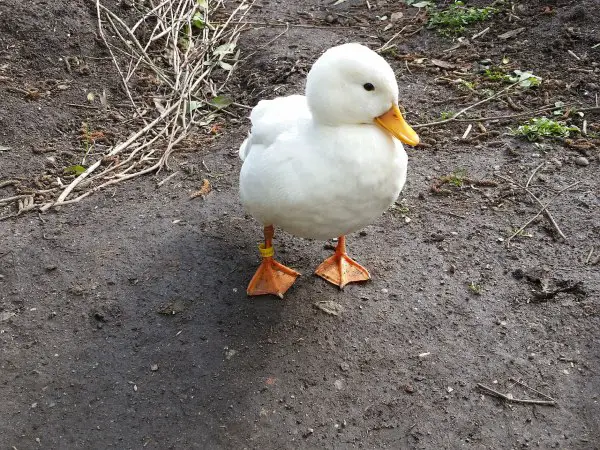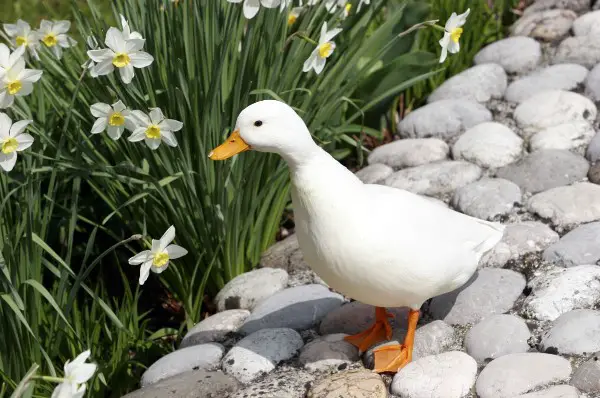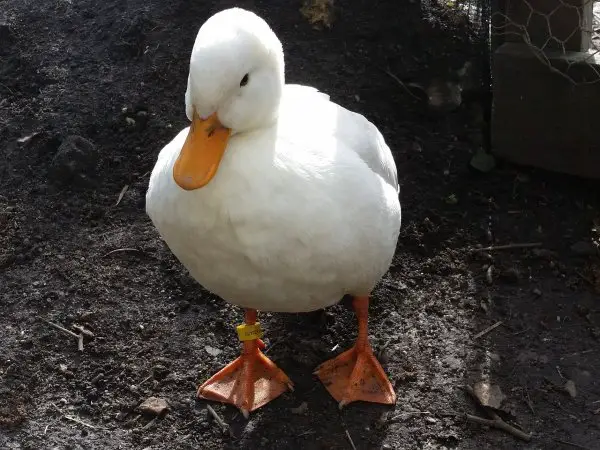The Call duck breed is a little bit different to other breeds that you may have encountered. Not so much in terms of looks, because we all now that it is the cutest of all breeds of duck. Instead, the Call duck was used for a completely different purpose than other ducks in the past.

We will talk more about that shortly, though.
Call Duck Breed Facts at a Glance
| Eggs | 24 +/- per year |
| Egg Shell Color | White |
| Temperament | Friendly and docile |
| Use | Show |
| Weight | Male: 26 oz (740 g) Female: 20 oz (570 g) |
| Country of origin | / |
| Foraging | Good |
| Admitted to APA | 1874 |
| Status | Watch |
The Origins of the Breed
Nobody really knows where the Call duck originates from. It is likely that it has been around for centuries and it is almost certainly a European duck, though. It almost certainly appeared before the 1850s too, because that is when it was first imported to the United Kingdom where it became classified as an official breed.
Most duck enthusiasts agree that the Call ducks were developed in the 17th century and that they were developed form ducks imported from China or Japan.
In the United States the breed was admitted to the APA back in 1874.
What is interesting about the Call duck is that it was never really raised as a duck breed for meat or eggs. It was a hunting duck (we will explain more about that in a short while), and this is what allowed it to become popular around the world.
Nowadays, the Call duck still exists, but it is not used for the same purposes as it was in the past. In fact, it is a wonder that it has managed to thrive. It is not even on the brink of extinction. We will come to this in due course, though.
The Appearance
The look of the Call duck isn’t that much different from the Mallard. However, let’s be honest. Most duck breeds are not.
The major difference is that the Call duck is one of the smallest duck breeds in the world. It also has a very small and tiny beak, and very large eyes compared to its size.
Both of these played into the main reason why people wanted to own the Call duck. It had a loud, high-pitched call.
Call Duck Colors
There are nine colors of Call duck recognized by the American Poultry Association:
- Blue Bibbed
- Blue Fawn
- Buff
- Butterscotch
- Chocolate
- Gray
- Pastel
- Snowy
- White
Blue Bibbed duck has bluish slate plumage with darker lacing, with laced blue or lavender tail.
The Blue Fawn has charcoal blue neck and head and blue-grey body feathers and tail.
Buff Call duck color variety has plumage in shade of rich fawn brown, the head and neck are rich fawn buff.
The White Call duck has pure white plumage.
The Snowy Call duck color variant is with green head with white to green neck. Its breast, shoulders and legs are claret laced in white with black on the tail and stern. It has gray wings.
Pastel Call duck has soft blue plumage overlaid with buff and gold. It has purplish-brown to rose breasts.
The Gray duck variant has head in lustrous green with white at the base of the neck. Purplish brown breasts and with steel to ashy gray body.
The Butterscotch call is the most cute color variety of all the colors available in Call ducks. This is very complicated color to breed and show.
The Use of the Call Duck as a Hunting Duck
We want to note that this is now illegal in the United States, but it is the main reason why the Call duck was bred all those years ago.
In the past, duck call whistles didn’t exist. So, people brought ducks along with them when they were hunting. The Calls were one of the best breed to bring along due to that incredibly loud and high-pitched call.

It drew in other ducks very, very quickly. In fact, the reason why Call ducks were banned from being hunting ducks is the fact that they were a little bit too effective at their jobs, and a lot of populations of ducks ended up being wiped out.
Now, you would think that when a bird loses its main purpose, it just disappears, right? Goes extinct. That is the case with most domesticated birds that lose their job. However, that never happened with the Calls. It adapted.
As a Show Duck
In the United States, the Call duck is the most popular duck of them all at shows. If you looked at rankings from official competitions, you will notice that the Call duck has won more major events than any other breed of duck.
This means that a lot of breeders are raising Call ducks. It is pretty difficult to raise the a duck for show if you are a new breeder, but it does go to show that most people find that this duck is so beautiful.
Those that do not take their ducks to shows will use them as ornamental birds in their garden.
The Call Duck for Eggs and Meat
You aren’t going to be getting a good meat or egg breed here.
The duck is too small to make it worth raising for meat, which makes sense since it is recognized as a bantam duck breed by APA.
We suppose that you could raise them for meat, but since there are so many better meat birds out there, it probably isn’t ideal. The Call duck is more of a pet than a bird that is meant to keep your family supplied with a steady source of food. It will only lay 24-eggs per year. They are seasonal layers too.
They will often lay these over the course of a couple of months and they will not produce anything for the other 10-months of the year. If the duck does lay fertile eggs, then they should be pretty easy to raise.
The Call duck does get quite broody and is a good sitter, although probably not a good enough sitter to introduce other duck breed’s eggs to her clutch outside of breeding season.
The Call Duck as a Pet
A lot of people recommend the Call duck as a pet. This is because it is incredibly simple to raise. In fact, it is one of the simplest of ducks to raise.
This is an incredibly friendly breed of duck. In fact, it is so friendly that a few petting zoos around the world use the Call duck because it very, very rarely attacks strangers.
It was a duck breed designed to be working alongside humans pretty closely, after all. Therefore, if you own a flock of Call ducks. then you can expect them to be friendly towards you the vast majority of the time.

Your one major concern will probably be the fact that the Call duck is a very, very vocal breed of duck. This was the whole reason why people loved this breed. You wanted it to be loud.
Most people do not want the duck to be loud, though. If you live in the middle of a town or city, or have neighbors a bit close to you, then you may want to steer clear of the Call duck. Your neighbors really, really will not be happy about it.
We think that this is important point to be aware of.
Other than this, just remember that the duck should be secure at all times. It is a smaller breed, so it is often the target of predators.
You may also want to clip their wings because this is a bird that does love to fly. While they will probably return to where you live since they know that this is going to be a major source of food for them, you can’t guarantee that.
Wing clipping is a painless procedure since you are just clipping some feathers. However, you will want to do a little bit of research into how you do it properly.
Comparing Call Ducks to Other Duck Breeds: A Comprehensive Overview
When it comes to raising ducks, enthusiasts have a wide variety of breeds to choose from, each with its own unique characteristics and qualities. Call ducks, known for their small size and distinctive vocalizations, stand out in the world of duck keeping. In this comparison, we’ll explore the key differences and similarities between Call ducks and several other popular duck breeds.
1. Call Ducks vs. Pekin Ducks:
Call Ducks:
- Size: Call ducks are notably smaller, weighing around 1 to 1.6 pounds, making them ideal for small spaces.
- Appearance: They have a compact body, a wide variety of colors, and a distinctive “miniature duck” look.
- Behavior: Call ducks are known for their charming quacking voice, which can be quite loud for their size. They are active, curious, and well-suited for small backyard ponds.
Pekin Ducks:
- Size: Pekin ducks are larger, typically weighing around 8 to 9 pounds.
- Appearance: They have a plump, white body and an orange bill and legs.
- Behavior: Pekin ducks are known for their friendly and calm demeanor, making them suitable for both pets and meat production.
2. Call Ducks vs. Indian Runner Ducks:
Call Ducks:
- Size: Call ducks are smaller and more compact, which makes them suitable for urban and backyard settings.
- Appearance: They come in various colors and exhibit the distinctive “mini duck” appearance.
- Behavior: Call ducks are active and vocal, often forming strong bonds with their owners.
Indian Runner Ducks:
- Size: Indian Runner ducks are taller and more upright in their posture.
- Appearance: They have a unique upright stance and come in various colors.
- Behavior: Indian Runner ducks are excellent egg layers and known for their busy and energetic behavior.
3. Call Ducks vs. Khaki Campbell Ducks:
Call Ducks:
- Size: Call ducks are much smaller in comparison.
- Appearance: They exhibit a wide range of colors and have a compact body.
- Behavior: Call ducks are known for their charming quacking and active nature.
Khaki Campbell Ducks:
- Size: Khaki Campbell ducks are medium-sized.
- Appearance: They have a khaki-colored plumage and a slender build.
- Behavior: Khaki Campbells are prolific egg layers and have a friendly disposition.
4. Call Ducks vs. Rouen Ducks:
Call Ducks:
- Size: Call ducks are significantly smaller.
- Appearance: They have a compact body and a variety of color options.
- Behavior: Call ducks are active and vocal, often forming close bonds with their caretakers.
Rouen Ducks:
- Size: Rouen ducks are larger and heavier.
- Appearance: They resemble Mallard ducks, with distinct coloration.
- Behavior: Rouen ducks are known for their calm and gentle nature.
5. Call Ducks vs. Muscovy Ducks:
Call Ducks:
- Size: Call ducks are much smaller than Muscovy ducks.
- Appearance: They exhibit a compact and adorable appearance.
- Behavior: Call ducks are active and known for their quacking vocalizations.
Muscovy Ducks:
- Size: Muscovy ducks are larger and heavier, with a distinctive appearance.
- Appearance: They have unique feather patterns, a red facial caruncle (in males), and a less pronounced quack.
- Behavior: Muscovy ducks are quiet and known for their insect-eating habits.
In summary, Call ducks stand out for their small size, distinctive quacking, and charming appearance. Their suitability for small spaces and active behavior make them a popular choice for backyard enthusiasts. When comparing Call ducks to other duck breeds, factors such as size, appearance, behavior, and purpose (egg laying, meat, ornamental) all play a role in determining the ideal breed for your specific needs and preferences.
